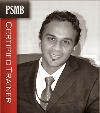 Creative Thinking and Problem Solving
Creative Thinking and Problem SolvingBy Dr Kamal Kenny 
Creative Thinking and Problem Solving Workshop Training Category: Soft Skills Target Audience: Management trainees, Executives, Middle Managers Duration: 2 days
For In-house Training »
For Customization & Other Inquiries »
Contact Dr. Kamal Kenny
Delivery Methods
|
Creative Thinking and Problem Solving Workshop“The art of being creative and knowing how to solve problems is fundamental in today's business.”By Dr Kamal Kenny
PhD in Gender Development • Master in Science • Degree in Social Science • PSMB
TTT Exempted • HRDF Claimable
IntroductionModern knowledge workers work almost exclusively in jobs that require them to solve business problems, take decisions, be able to 'see the big picture' and think about consequences. Most people, once they leave the formal education system, do not focus on any further learning or continuing to develop their thinking skills. As their careers progress, they become more expert in a few things, but less capable in dealing with or understanding things outside their domain of expertise. They become competent at solving problems that are routine, but are less able to apply these problem solving skills in wider contexts. Research shows that most people only use a fraction of their cognitive abilities. Yet the ongoing exercise of the brain function (like a focus on physical health and doing physical exercise) can reduce mental debilitation throughout life. The course describes various thinking styles; delegates come away with a greater appreciation of the way they think. The course has many interesting and fun problem-solving exercises, but the real value is that delegates go away with a fresh outlook on organizational problem solving, and are motivated to expand their cognitive horizons. Course ObjectiveOn completion of the programme, participants will be able to:
Course OutlineD A Y 1INTRODUCTION
MODULE 1: UNDERSTANDING PROBLEM SOLVING PROCESS
MODULE 2: UNDERSTANDING PROBLEM ANALYSIS
MODULE 3: THINKING PROCESS
MODULE 4: BRAINSTORMING
MODULE 5: ANALYTICAL AND CREATIVE THINKING SKILL
D A Y 2MODULE 6: IDENTIFYING PROBLEMS
MODULE 7: USING DMAIC MODEL IN SOLVING PROBLEMS
MODULE 8: APPRECIATE CREATIVITIES AND IDEAS BY OTHERS
MODULE 9: ACT AND PERFORM AS EXCELLENT STAFF
MODULE 10: SETTING OBJECTIVE AND ACTION PLAN
MethodologyWhere appropriate, activities will include the following:
|
Related Training Courses:
- Box Breaking Problem Solving & Decision Making Skills
- 8D Problem Solving Methods
- Synergized Problem Solving Using Analytical & Creative Thinking
- Magic of Pause
- More other Soft Skills training courses
More Other Training Courses:
- Business Management Training Courses
- Manufacturing Operation Training Courses
- Health & Safety Training Courses
- Commercial Arts Training Courses
- Browse All Training Courses by Category






